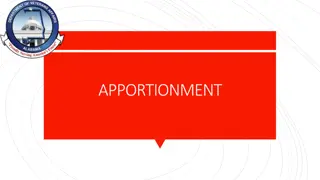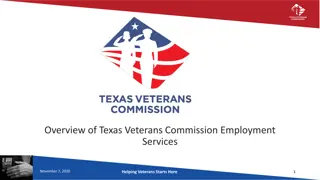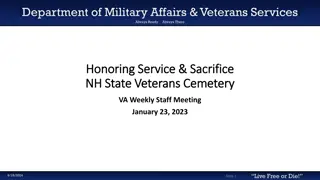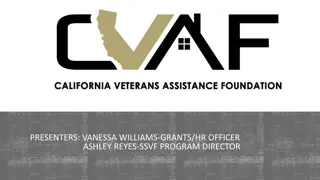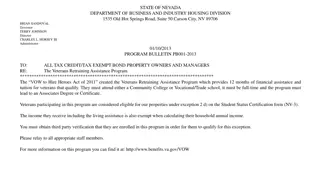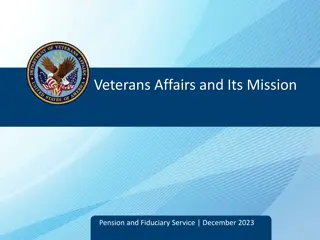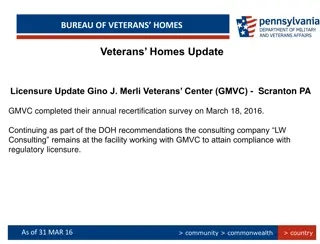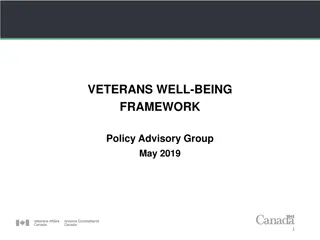Veterans Disability Claims Evaluation: Regulations and Policy Update
A detailed overview of the regulations governing re-ratings and re-examinations in veterans' disability claims. Includes insights on why consistency in evaluations is crucial, reasons for excluding veterans from re-examinations, and statistics on unwarranted medical reexaminations. Emphasis on the importance of considering each disability in relation to its history and ensuring thorough examinations for accurate evaluations.
Download Presentation

Please find below an Image/Link to download the presentation.
The content on the website is provided AS IS for your information and personal use only. It may not be sold, licensed, or shared on other websites without obtaining consent from the author. Download presentation by click this link. If you encounter any issues during the download, it is possible that the publisher has removed the file from their server.
E N D
Presentation Transcript
Winter 2021 Virtual Training Conference Presenters: Katrina J. Eagle, Esq. Jim Radogna, VA Accredited Agent
38 C.F.R. 4.1 Over a period of many years, a veteran's disability claim may require re- ratings in accordance with changes in laws, medical knowledge and his or her physical or mental condition. It is thus essential, both in the examination and in the evaluation of disability, that each disability be viewed in relation to its history.
38 C.F.R. 4.2 Different examiners, at different times, will not describe the same disability in the same language. . . . It is up to the rater to interpret the examination reports in light of the whole recorded history... Each disability must be considered from the point of view of the veteran working or seeking work
As a matter of VA policy, Veterans should be excluded from re- examinations if one or more of the following reasons exist: Over 55 years old at the time of the examination, and not otherwise warranted by unusual circumstances or regulation Permanent disability not likely to improve Disability without substantial improvement over five years Claims folder contains updated medical evidence sufficient to continue the current disability evaluation without additional examination Overall combined evaluation of multiple disabilities would not change irrespective of the outcome of reexamining the particular condition Disability evaluation of 10 percent or less Disability evaluation at the minimum level for the condition
A report released by the VA in July 2018, titled Unwarranted Medical Reexaminations for Disability Benefits, said of approximately 53,700 veterans cases subjected to reexaminations in a six-month review, 19,800 (37%) were unwarranted
38 C.F.R. 3.344(a). For ratings in effect for 5 years or more, the RO must review the entire record of examinations and the medical-industrial history to ascertain whether the recent examination is full and complete Examinations less full and complete than those on which payments were authorized or continued will not be used as a basis of reduction. If one C&P exam is taken out in isolation from the rest of the record, and that one exam says that the disability has improved while the rest of the records do not show that, the VA cannot base their proposal of a VA rating reduction on that one exam.
38 C.F.R. 3.344(a): Stabilization of disability evaluations, cont d: If the disability is subject to temporary and episodic improvement, e.g., manic depressive or other psychotic reaction, . . . etc., it will not be reduced on any one examination, except in those circumstances in which all the evidence of record clearly warrants the conclusion that sustained improvement has been demonstrated.
38 C.F.R. 3.344(a): Stabilization of disability evals, cont d: Ratings on account of diseases which become comparatively symptom-free after prolonged rest, e.g., residuals of phlebitis, arteriosclerotic heart disease, etc., will not be reduced on examinations reflecting the results of bed rest
38 C.F.R. 3.344(a): Stabilization of disability evaluations, cont d: Rating boards encountering a change of diagnosis must exercise caution in the determination as to whether a change in diagnosis represents no more than a progression of an earlier diagnosis, an error in prior diagnosis or possibly a disease entity independent of the service- connected disability.
38 C.F.R. 3.344(a): Stabilization of disability evaluations, cont d: Even though material improvement in the physical or mental condition is clearly demonstrated, the VA will consider whether the evidence makes it reasonably certain that the improvement will be maintained under the ordinary conditions of life.
38 C.F.R. 3.344(b): Doubtful cases: If doubt remains, after according due consideration to all the evidence developed, the rating agency will continue the rating in effect. The rating agency will determine on the basis of the facts in each case whether 18, 24, or 30 months will be allowed to elapse before re- examination will be made.
38 C.F.R. 3.957: Service Connection: Service connection for any disability or death granted which has been in effect for 10 or more years will not be severed except upon a showing that the original grant was based on fraud or it is clearly shown from military records that the person concerned did not have the requisite service or character of discharge.
38 C.F.R. 3.957: Service Connection, cont d: The 10-year period will be computed from the effective date of VA s finding of service connection to the effective date of the rating decision severing service connection. The protection afforded in this section extends to claims for DIC.
38 C.F.R. 3.951(b): Preservation of disability ratings: A disability which has been continuously rated at or above any evaluation of disability for 20 or more years for compensation purposes . . .will not be reduced to less than such evaluation except upon a showing that such rating was based on fraud. If the rating fluctuated for twenty years, it can t be reduced below whatever the lowest rating was during those twenty years
38 C.F.R. 3.343(a): Continuance of total disability ratings: Total disability ratings, when warranted by the severity of the condition and not granted because of IU will not be reduced, in the absence of clear error, without examination showing material improvement in physical or mental condition. Exam reports showing material improvement must be evaluated in conjunction with all of the facts of record, and consideration must be given particularly to whether the veteran attained improvement under the ordinary conditions of life
"Material improvement" is more than a temporary remission of a chronic condition To find that there has been a "material improvement," the VA must: Compare the exam that led to the 100% rating to the pre-reduction exam Consider the entire medical history of the particular disease or injury Look to see whether there has been a change to the veteran's ability to "function under the conditions of daily life." If all of these criteria are not met, there has not been a material improvement
A private medical opinion stating that the claimant has not medically improved since the 100 percent evaluation was assigned or continued can be crucial in these cases.
38 C.F.R. 3.343(c): Individual Unemployability If VA determines that a reduction in a 100% rating is warranted, but the record reflects that the veteran is unable to engage in substantially gainful employment by virtue of his or her service- connected disability, the veteran must be awarded a total rating based on TDIU Moreover, once a veteran is in receipt of benefits at the total rating level based on TDIU, the VA may not reduce the benefits unless clear and convincing evidence establishes that the veteran is capable of actual employability
The Secretary shall from time to time readjust this schedule of ratings in accordance with experience. However, in no event shall such a readjustment in the rating schedule cause a veteran s disability rating in effect on the effective date of the readjustment to be reduced unless an improvement in the veteran s disability is shown to have occurred. 38 U.S. Code 1155
The M21 Manual provides requirements that the VA raters must follow when adjudicating rating reductions: In all rating reduction cases, to include those involving an evaluation that has not been in effect for five years or otherwise stabilized, a reduction in the evaluation may only be effectuated if the improvement is shown by a thorough examination adequate for rating purposes, as required in 38 CFR 4.2 and 38 CFR 4.10, and reflects an improvement in ability to function under the ordinary conditions of life, including employment. M21-1 III.iv.8.D.1.b.
Any proposed reduction must be based upon review of the entire history of the veteran s disability The VA must determine whether there has been an actual change in the disability Any improvement must reflect an improvement in the veteran s ability to function under the ordinary conditions of life and work Examination reports reflecting any such change must be based on thorough examinations
A reduction in a veterans disability evaluation is NOT permitted merely because a later adjudicator has a different opinion on how the evidence or the rating schedule should be interpreted. VA bears the burden of proof in establishing, by a preponderance of the evidence, that a reduction is warranted under the relevant regulations.
VA can only properly sever service connection for a veteran s disability if there is finding of fraud, if a clear and unmistakable error was made in the decision that granted service connection or the VA discovers that the veteran did not have the required length or character of service In cases where the veteran has been service connected for the condition for ten years or more, VA can no longer sever SC on the basis of CUE The process for severing service connection is identical to that for reduction of benefits, and the due process protections are the same
Per 38 C.F.R. 3.105(d): VA has established that service connection will be severed only where evidence establishes that it is clearly and unmistakably erroneous (the burden of proof being upon the Govt). A change in diagnosis may be accepted as a basis for severance action if
Per 38 C.F.R. 3.105(d): the examining physician(s) certify that, in light of all accumulated evidence, the diagnosis on which service connection was predicated was clearly erroneous. This certification must be accompanied by a summary of the facts, findings, and reasons supporting the conclusion.
In order to sever SC, VA must show more than that there is just a difference of opinion For instance, if one C&P examiner diagnoses a veteran with depression, and he is granted service connection based on that opinion, the fact that a later C&P examiner instead diagnoses the veteran with a personality disorder is not enough in and of itself to sever service connection The VA is required to look at the evidence as a whole to determine whether the original grant of service connection was clearly erroneous An inadequate medical opinion should not suffice to establish that a prior diagnosis is clearly and unmistakably erroneous
38 U.S.C.S. 6103 provides that a person who knowingly makes a false or fraudulent statement concerning any claim for VA benefits forfeits his or her rights to VA benefits The decision as to whether the evidence warrants formal consideration of forfeiture due to fraud is made by the VARO Regional Counsel If the affected claimant receives an adverse decision from the VARO, he or she may appeal this decision to the BVA, and if the Board denies the claim, an appeal may be taken to the CAVC
A claimant facing a reduction or severance must be given prior notice of the proposed adverse action and given at least 60 days after the notice within which to submit evidence for the purpose of showing that the adverse action should not be taken The claimant has a right to a predetermination hearing but it must be requested within 30 days from the date of the notice of the proposed adverse action DO NOT file an appeal in response to a proposal to reduce or sever; simply respond to the VA notice letter
If the claimant does not submit evidence within the 60-day period, a final rating decision will be prepared. The veteran is notified of the final rating decision and the award of benefits will be reduced. A new 60-day period begins from the date of the final decision. The reduction goes into effect on the last day of the month on which the new 60-day period expires.
Improper rating reductions or severances, in which the decision is now final, may be appealed just like any adverse VA decision Submit lay evidence from those who witness the effect that the disability has on the Veteran s daily life Lay statements can be completed by the veteran themselves, a spouse, family members, co-workers, etc. Consider a private medical opinion that shows that the veteran s condition has not improved (reduction) or is c0nnected to service (severance)
Feel free to contact us about questions from this training or ANYTIME you have a question about a claim: CACVSO@eagleveteranslaw.com

 undefined
undefined






